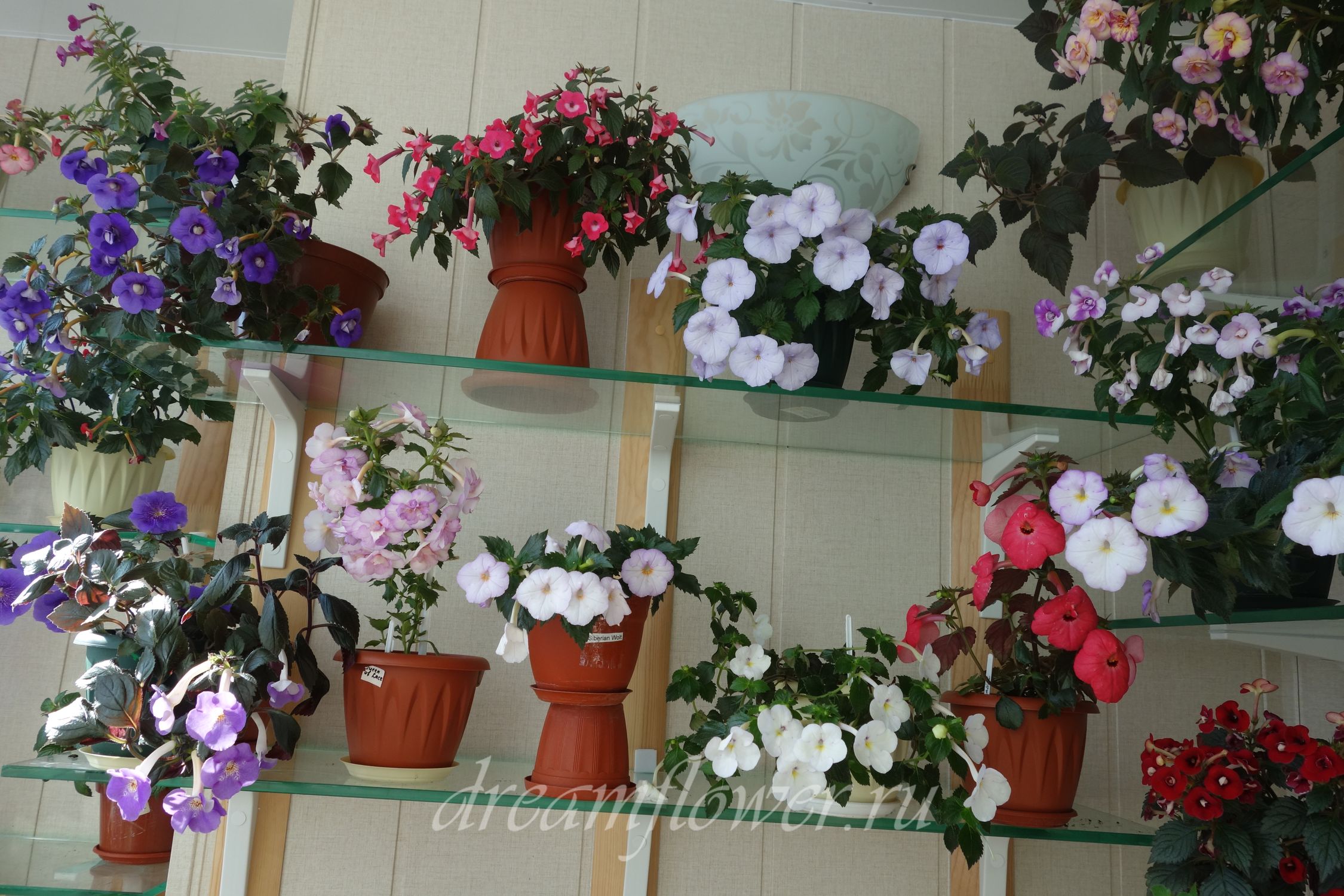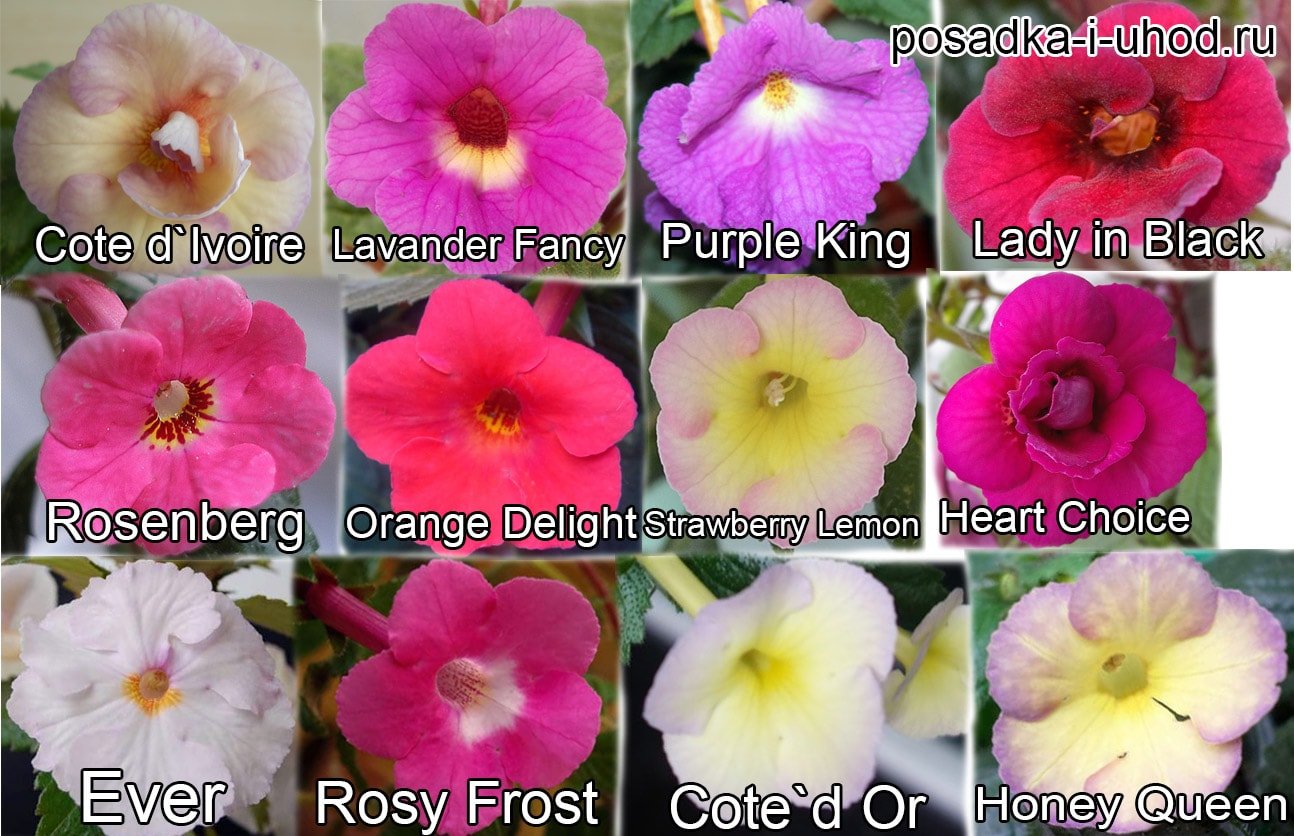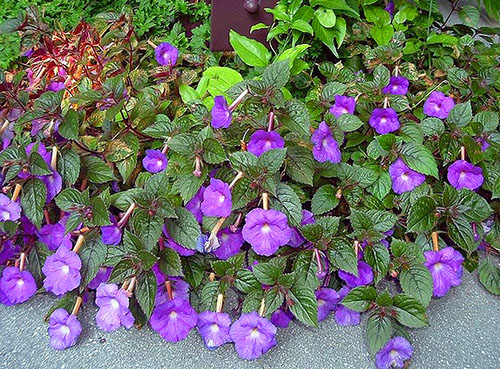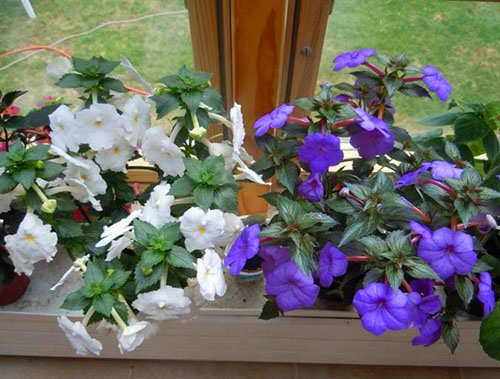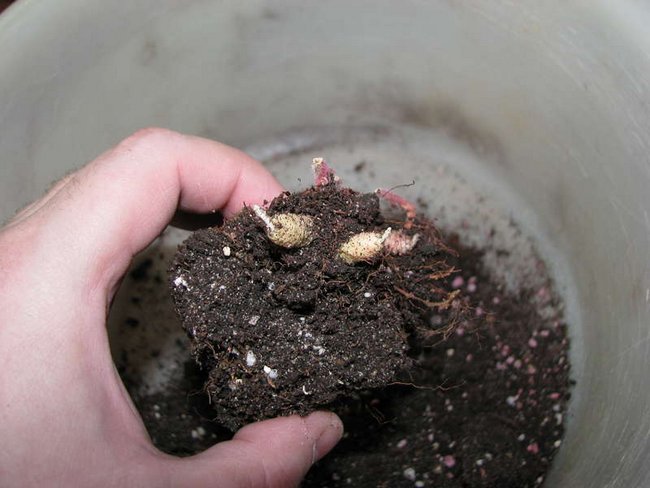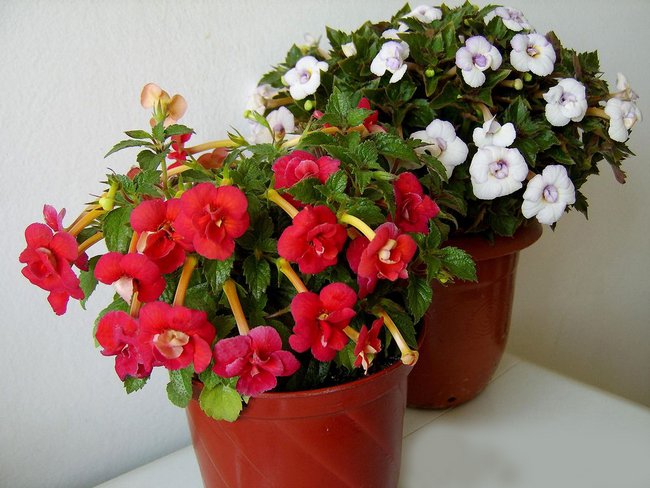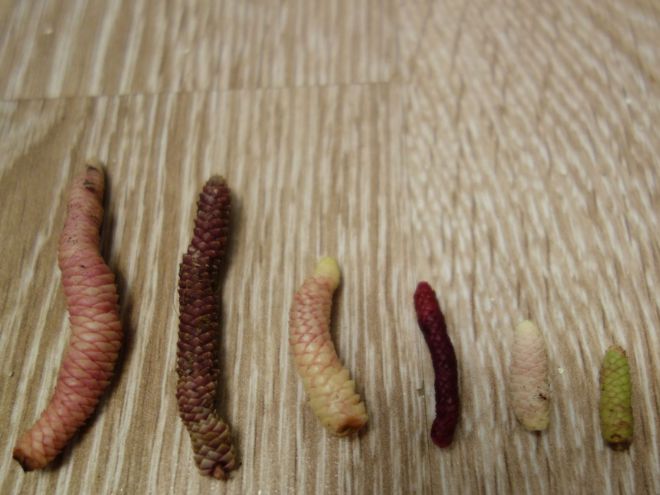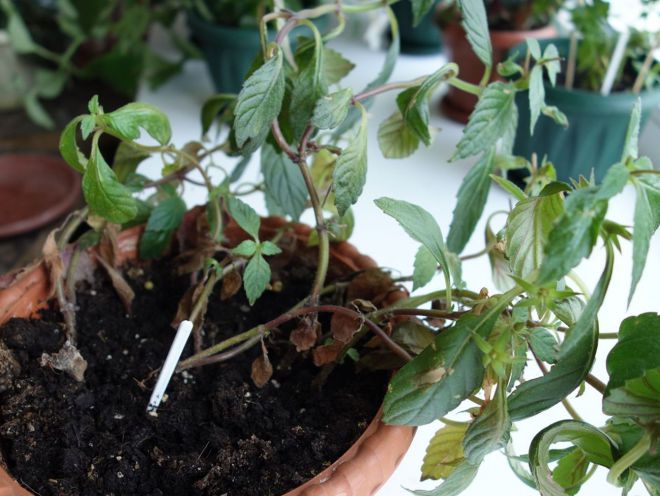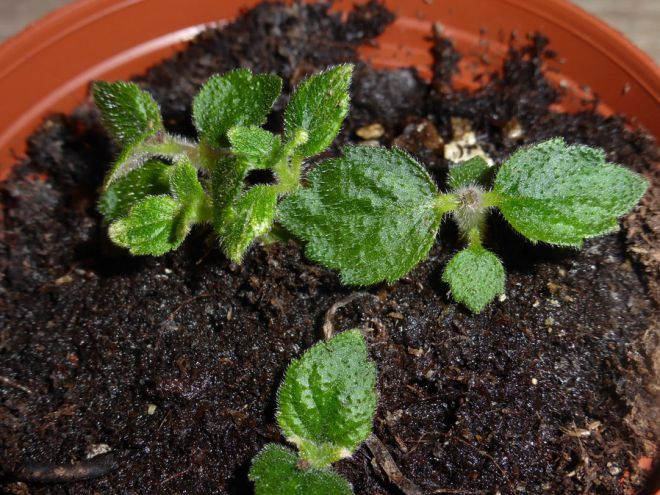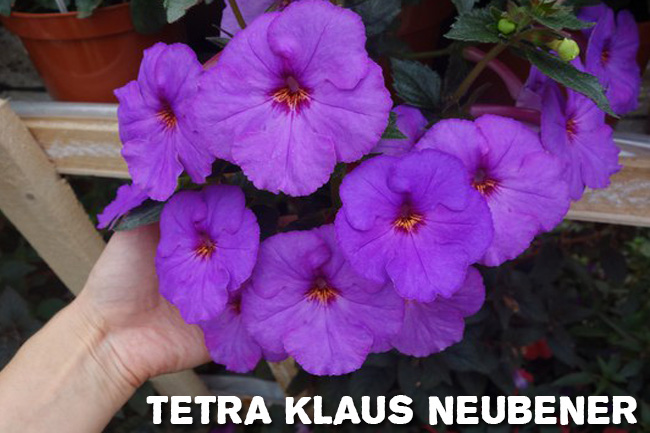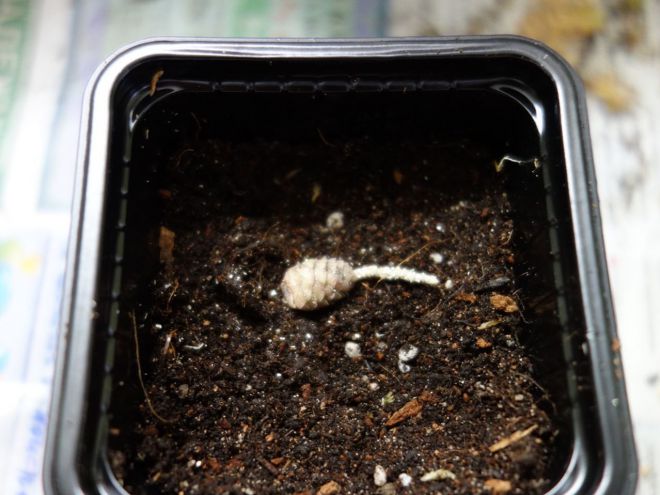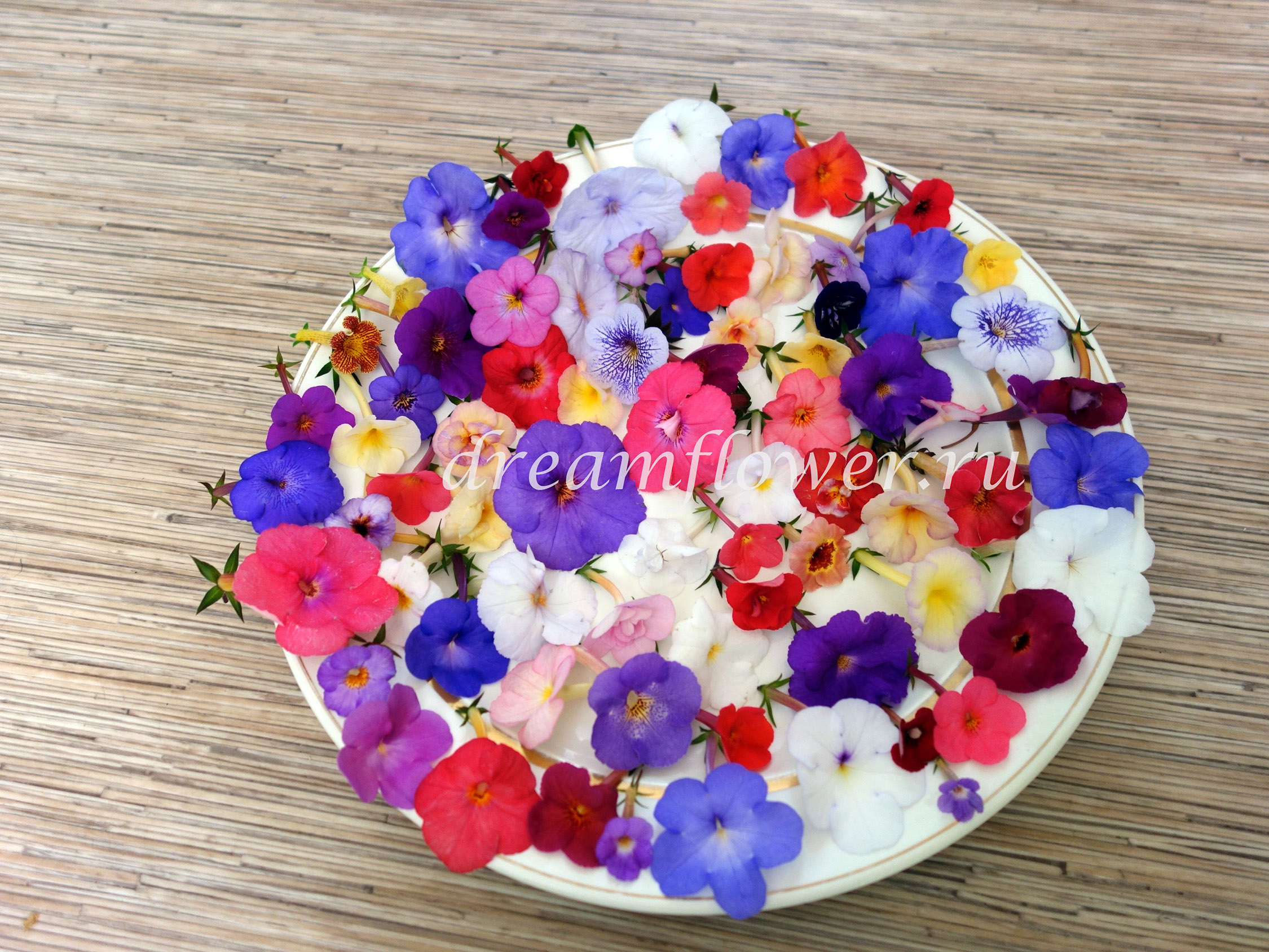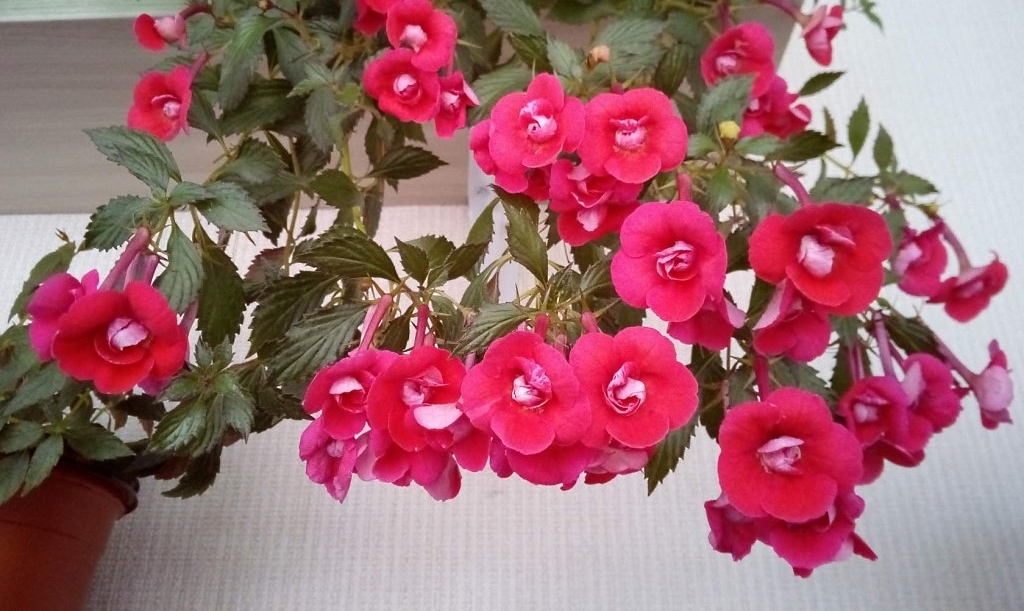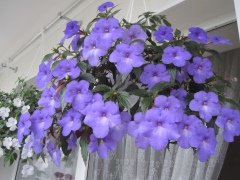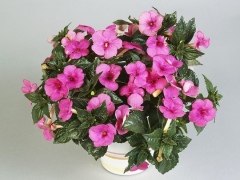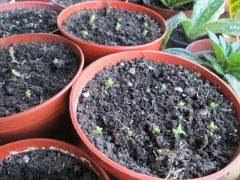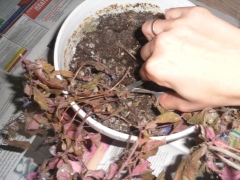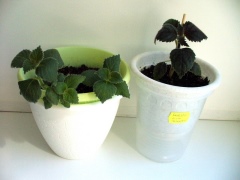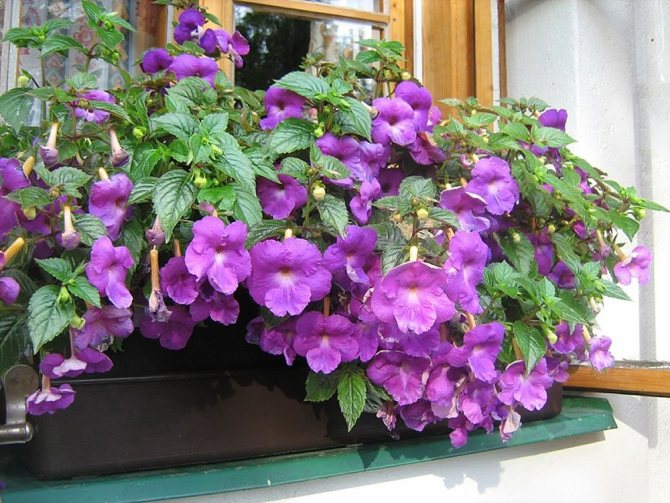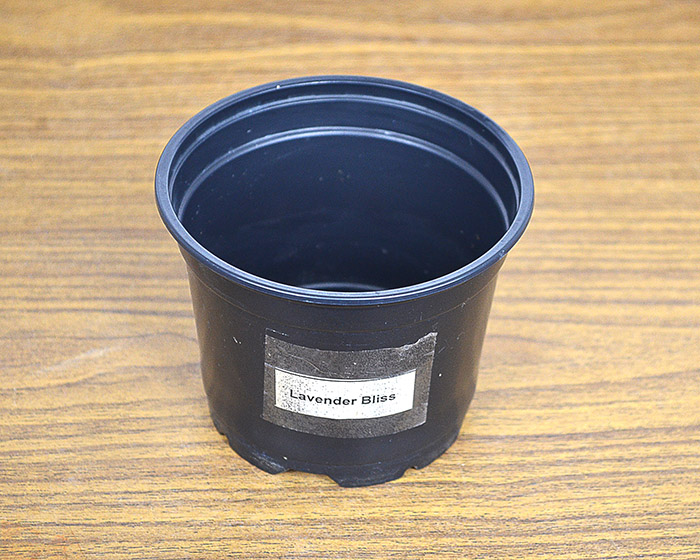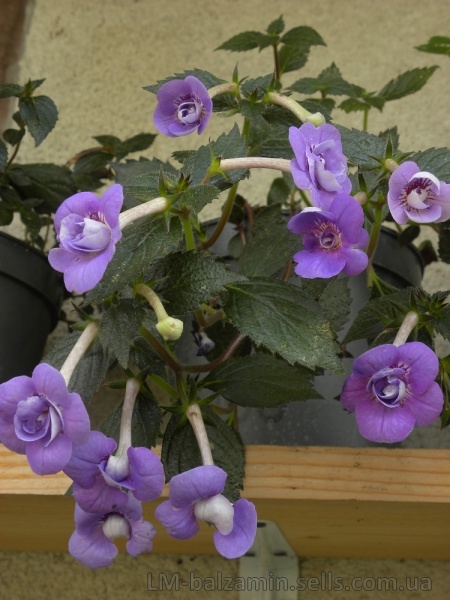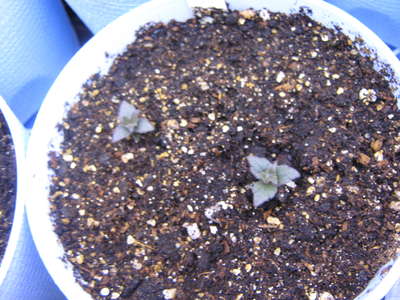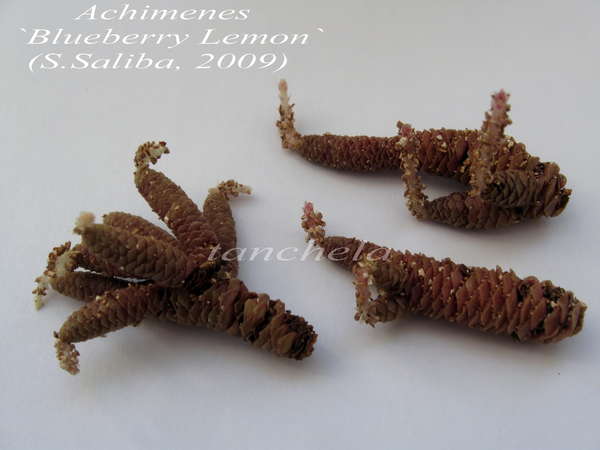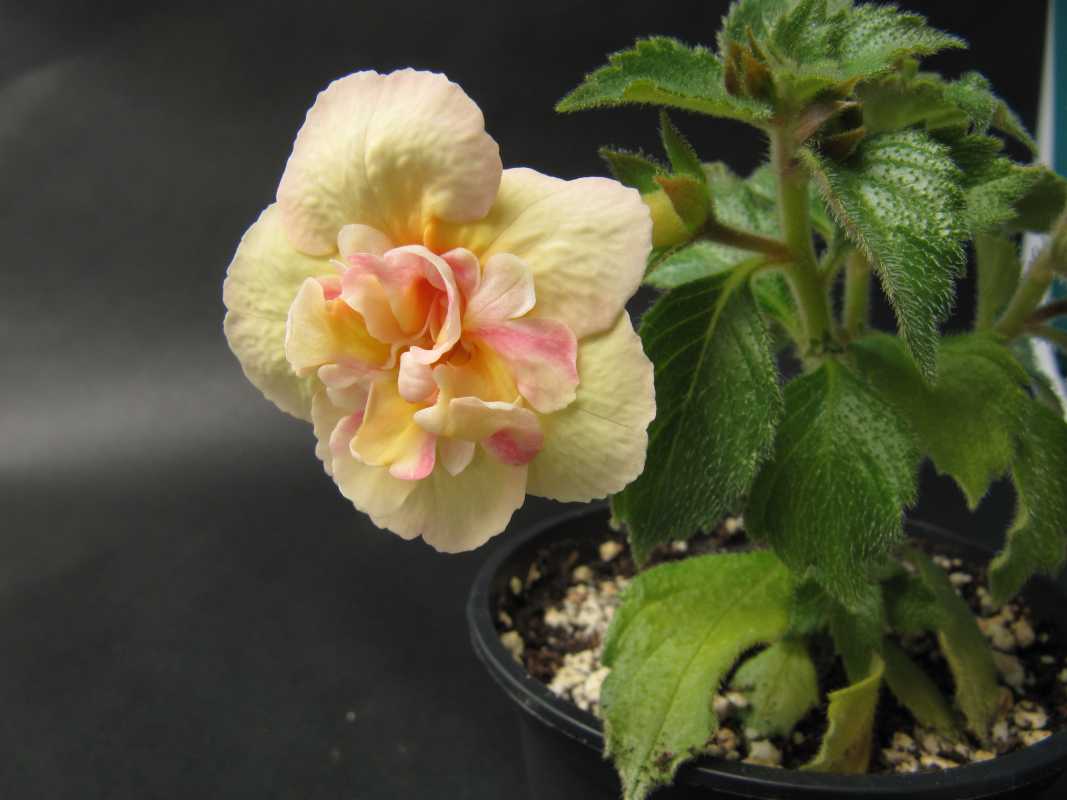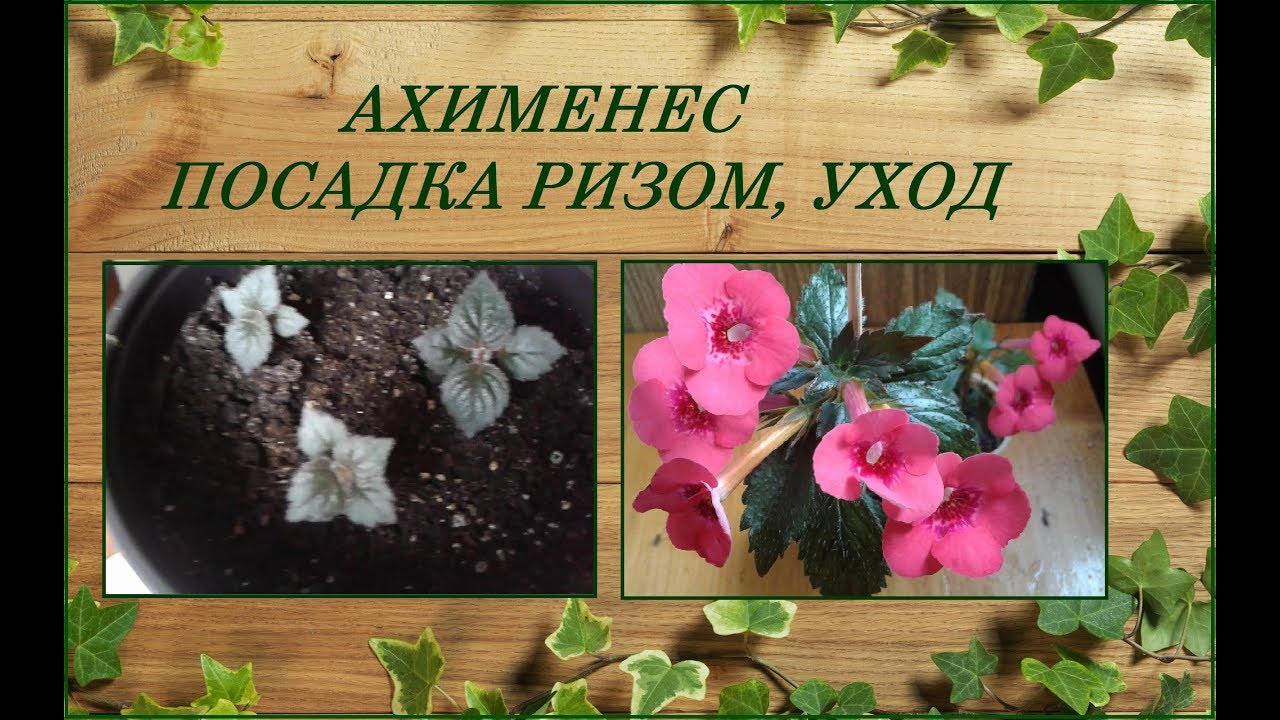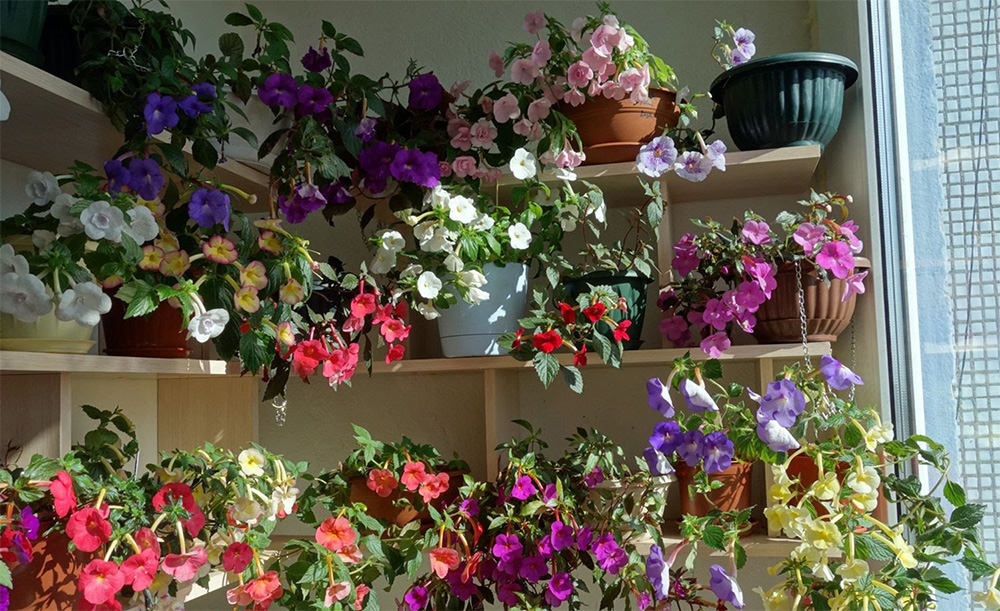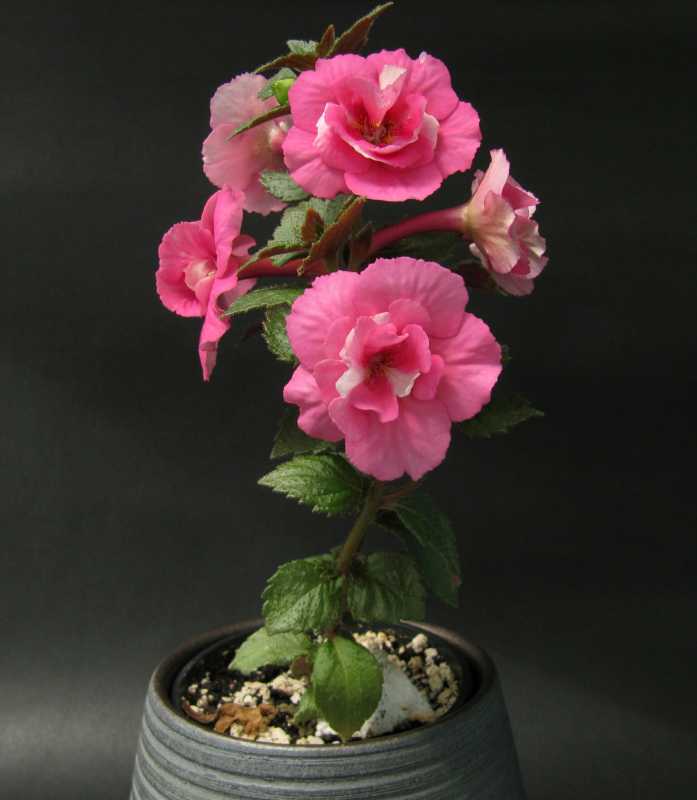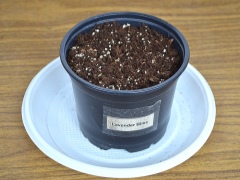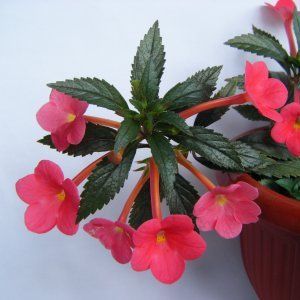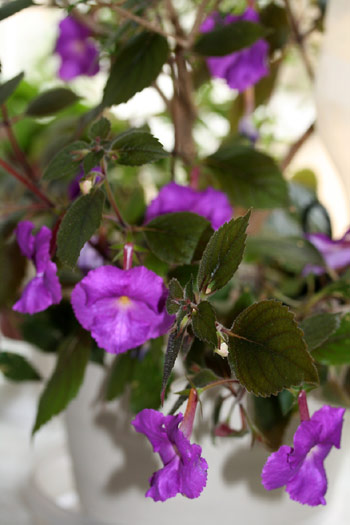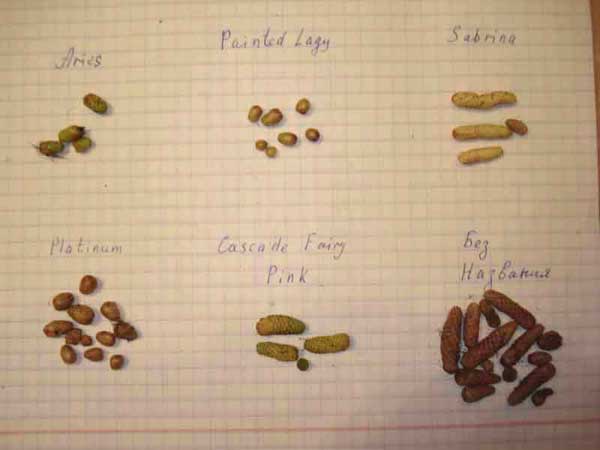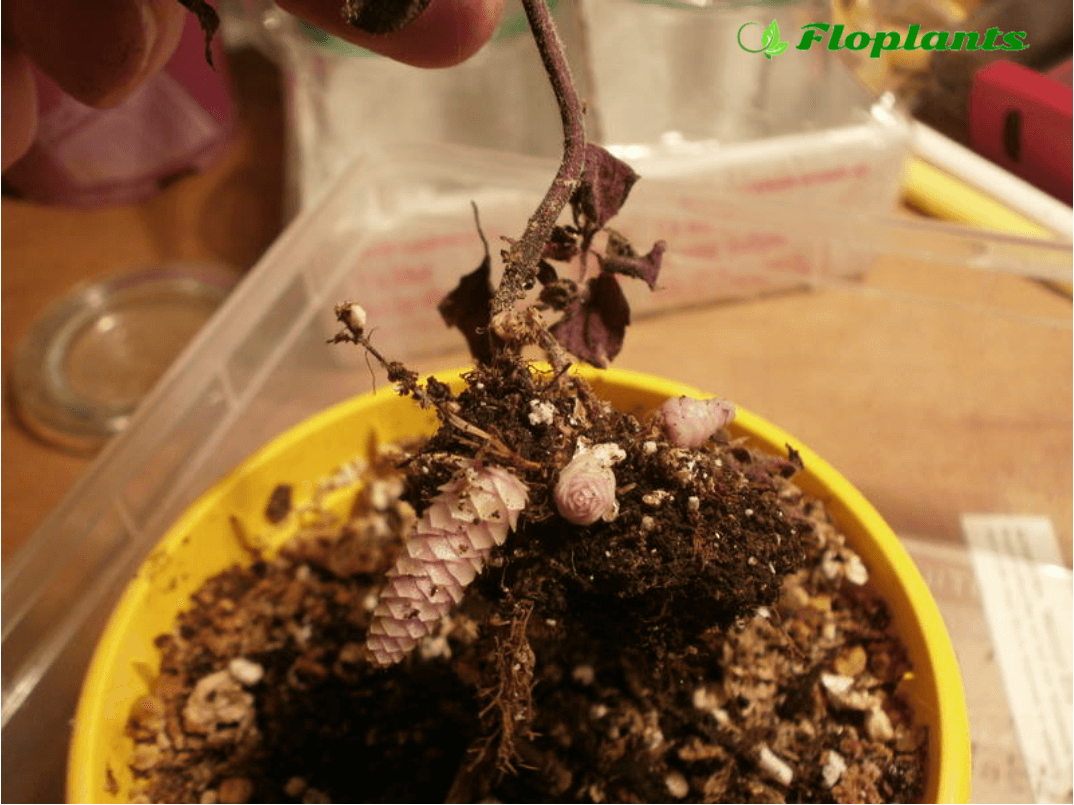The subtleties of pinching and pinching
Now comes the fun part. How to form a bush so that you can't take your eyes off it during flowering. At the earliest stages of the growth of achimenes, we begin to form the plant by pinching.

When 2-3 pairs of leaves grow on the plant, we remove the crown with nail scissors - this is pinching. We do not throw out the tops of the heads - they, in parallel with the plants from the rhizomes, will give rise to new bushes and have time to grow a bush no less than the plants from the rhizomes. Reproduction by pinning tops is an easy and reliable way of breeding achimenes.

In a small plastic cup with drainage (you can break the foam) and soil, we place these tops of the head the size of a match head.
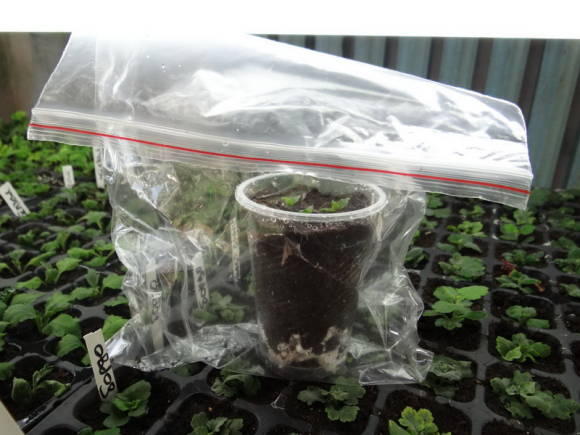
We press the tops of the heads a little into the ground, lightly spray them from the spray bottle, put them in a bag with a zip-fastener and place them under the supplementary lighting. After 10 days, the cuttings grow up - this is a sign of rooting.
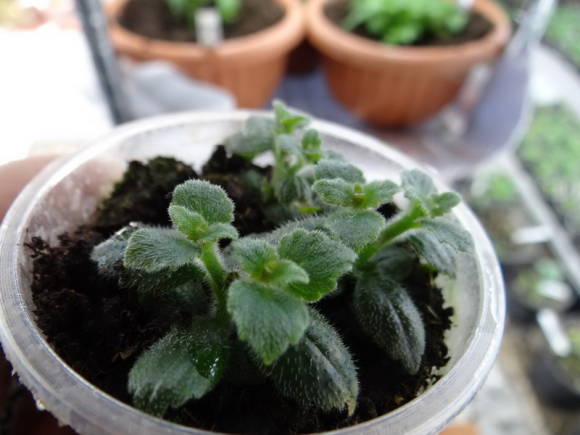
After 10 days, the plant, whose crown has been pinched, gives out two shoots, but in general there can be 3 or even 4. We repeat the pinching-pinching. These tops can also be rooted. So I pinch the plant from 4 to 7 times, until the buds appear.
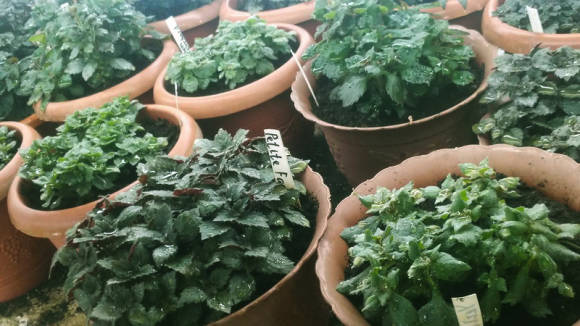
Here are the Achimenes formed, ready to bloom
Prishipka, of course, will postpone flowering for a week or a half, sometimes 20 days, but then it will be so gorgeous, then you will understand that it is worth it!
I pinch all varieties indiscriminately. The only variety, Ambroise Vershaffelt, does not bush well after pinching and does not need to be pinched.
What to do in case of early appearance of rhizome?

Sometimes it happens that sprouts appear at the wrong time. There is no point in planting them in the soil in winter, since the biological development cycle of the future flower will be disrupted.
In this case, you can, of course, plant rhizomes, in the hope that after two years the flower will adapt. But you need to tighten the sprout formation time as much as possible. This can only be achieved by lowering the ambient temperature. In any case, lighting should be bright and last 12-16 hours a day. Otherwise, the sprout will form weak.
You can try another method: leave the rhizomes in a cool and dark place for three to six weeks, and then plant them. Agree, this is a decent delay.
Growing achitmenes from rizom is a fascinating business. I am sure you will enjoy this activity.
Olga Danilina
Description of the origin and appearance of the plant
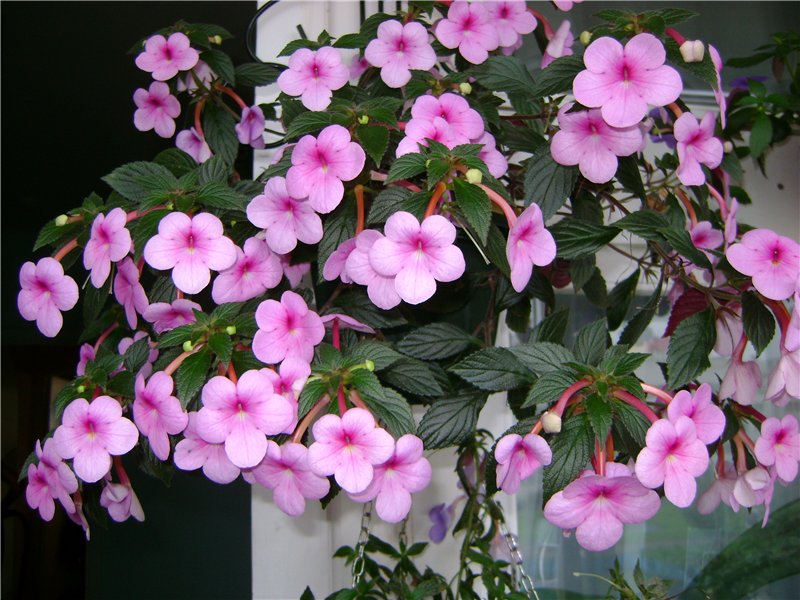 The Achimenes have distinctive decorative foliage and spectacular flowers.
The Achimenes have distinctive decorative foliage and spectacular flowers.
Modern hybrids and varieties of achimenes bear little resemblance to plants brought in the 18th century from the tropics of America to European gardens. For the first time they began to breed in culture in the late 1780s. During the Victorian period, they quickly gained popularity as potted flowering plants, when more than 60 varieties were developed by hybridizers. In the 1940s, Achimenes breeding began in Germany, the Netherlands and the United States. But plants were more common in Europe than in the United States.
In Russia, Achimenes were not as common in the collections of gardeners as Gloxinia and Saintpaulia (other species of the Gesneriev family). Unfortunately, over the past 100 years, many of the varieties have been lost. Currently, as a rule, growers grow only a limited number of species. But the flower is gaining popularity again.
Like most plants in this family, the Achimenes have distinctive decorative foliage. But when growers see the charming bloom of achimenes, they will certainly become enthusiasts in its cultivation, especially since the care is very simple.
Under natural conditions, achimenes grows in the tropical rainforests of South and Central America. Plants grow from small rhizomes, which are very different in their shape and size from other plants of the Gesneriev family. The roots (rhizomes) resemble small pine cones or alder catkins.
The pubescent shoots with elongated velvety leaves depart from the rhizome, while the underside of the leaf blades is colored dark red. Achimenes blooms in spring, the shoots are covered with cute flowers of white, purple, blue, yellow or red. The plant is not large, but some types of achimenes grow up to 60 cm in height.
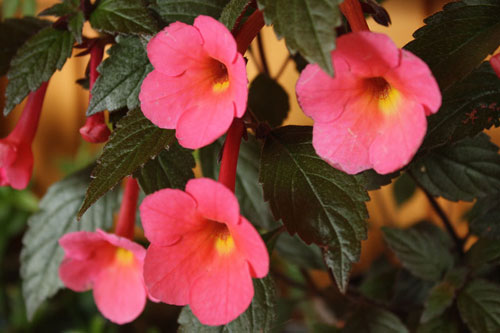 Achimenes blooms in spring, it is covered with white, purple, blue, pink, yellow or red flowers
Achimenes blooms in spring, it is covered with white, purple, blue, pink, yellow or red flowers
Achimenes species diversity
- Long-flowered Ahimenes is an ampelous flower reaching 30 cm in height. Narrow leaf blades of a light green shade, slightly pubescent. Purple, white or yellow flowers with stripes near the throat are rather large (5 cm in diameter).
- Achimenes grandiflorum is found naturally in Mexico. Its leaves are much larger than those of long-flowered achimenes. Their length reaches 10 cm, and their width is 6 cm. The main color range of flowers is purple. They grow in groups, two flowers can grow from one sinus.
- Achimenes fringed has very graceful snow-white flowers with a beautiful fringe around the edges.
- Achimenes erectus has a compact form with a height of 25 to 45 cm. Its shoots have a reddish tint. The flowers are small (up to 1 cm in diameter), painted in all sorts of shades of red.
- A small compact shrub forms Achimenes varifolia. Stems with dark red leaves. The flowers are large - up to 5 cm in diameter. The corolla tube is fiery red, the pharynx is yellow, and the petals are painted with yellowish spots.
- Stems are brown in Achimenes prostrate. The flowers are single, small (about two centimeters in diameter), lilac.
- Achimenes Mexican has very showy flowers. They are purple with a white neck, and there are also varieties with purple, violet, pink or snow-white flowers.
Rhizome storage rules
The place and method of storage with the rhizome of achimenes depend on the number of copies and the personal preferences of the grower himself. For example, they can be left in the same planting containers in which the plants grew, or they can be removed for storage in another place.
In the first case, it is necessary to remove all aerial parts of the plant, and then remove the pot in a dark, relatively cool place without high humidity. The best temperature values for storing the rhizomes of a crop will be + 10 ... + 18 ° C, and as for care, any moisture or feeding should be excluded.
Throughout the winter period, you will have to periodically check the condition of the rizom, controlling their awakening. If sprouts appear above the soil line, you will have to update the top soil layer by adding fresh and loose substrate. To prevent the emergence of sprouts, you can remove rhizomes from the ground, remove damaged and diseased roots, clean the rhizome from adhering soil and thin roots and dry, after which it remains only to place them in dry, transparent, hermetically sealed bags, restoring each layer with vermiculite, perlite or peat-sand mixture (second storage method).
To prevent the emergence of sprouts, you can remove rhizomes from the ground, remove damaged and diseased roots, clean the rhizome from adhering soil and thin roots and dry, after which it remains only to place them in dry, transparent, hermetically sealed bags, restoring each layer with vermiculite, perlite or peat-sand mixture (second storage method).
It is much easier to store the rhizome of achimenes in this form in winter, because they are not only compactly located, but also much easier to control their condition. If there are signs of condensation, you can always open the bag and ventilate the rhizomes, which helps to avoid the appearance of mold.
Did you know? The name of the genus is translated from Greek as "intolerant of cold (not wintering)", but in the common people you can often find the designation "twisted carp", which came from the characteristics of the fruit.
In general, storage and further reproduction of Achimenes with the help of rhizomes will not be difficult, both for an experienced and a novice florist.
Therefore, if you do not know which flowering plant to give preference to, pay attention to the described flower
Was this helpful?
Thank you for your opinion!
You can recommend the article to your friends!
You can recommend the article to your friends!
Yes
No
ACHIMENES-HOW TO PLANT RIZOMES
1. Take the sprouted rhizome. If you have purchased a new variety, then, as a rule, it will come to you in such a bag in vermiculite.
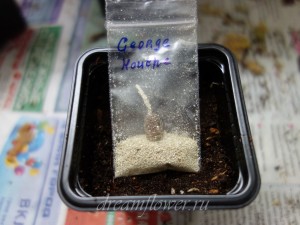
2. Place the rhizome horizontally on the ground, best of all (if it is one) in the middle of the pot.

3. (optional) You can pour out the vermiculite in which it was stored, suddenly there are micro-bowls in it, which can also germinate.

4. Sprinkle the rhizome (s) with a small layer of soil (1.5-2 cm.)

5. Water the planted rhizome, only light moisture is needed, no more.

6. We make the signature of the variety, if necessary
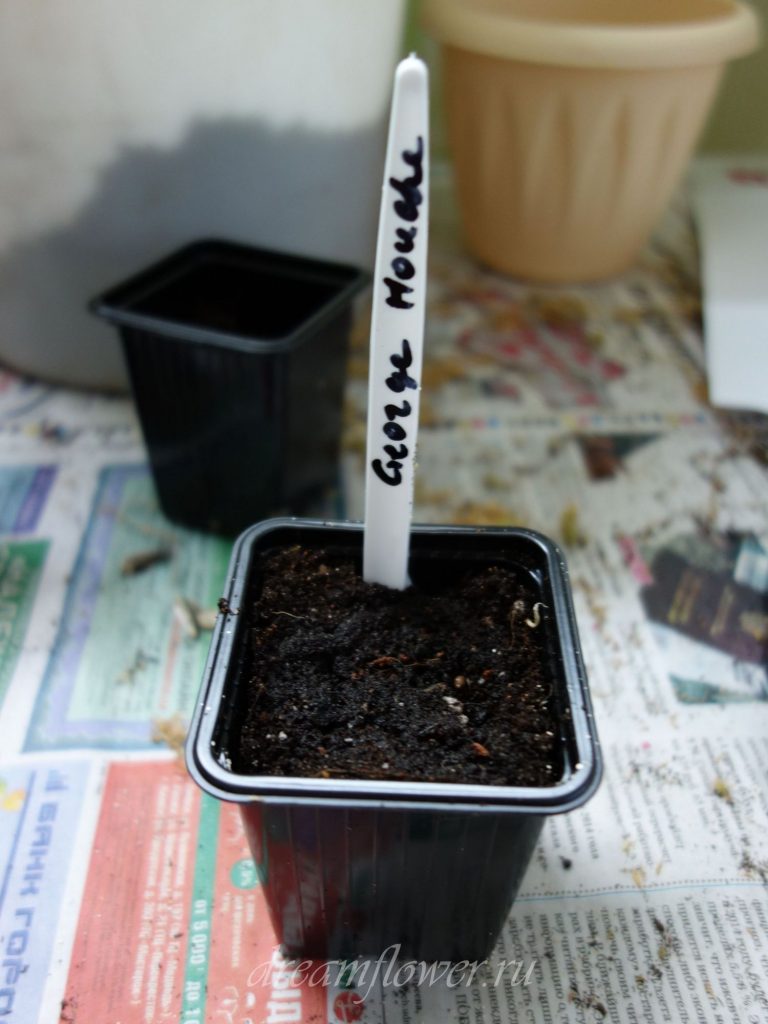
7. We put on a bright place (in the photo - under the lamps) and wait for the sprouts. Can be slightly moisturized once a week.

HOW MUCH RIZOM IS NECESSARY FOR A POT
There are various guidelines for the amount of rhizomes needed to create a beautiful, lush bloom. We can say that everything here is quite relative and depends largely on the variety and growing conditions. For example, many modern varieties, subject to agricultural technology, show very good results even when planting 1 rhizome per pot with a diameter of 10-11 cm. Others, on the contrary, require dense planting of 3-4 rhizomes on the same pot. Romanian collector Serge Saliba uses the following formula for himself: 5 rhizomes per 16.5 cm pot, while taking additional time to pinch growing achimenes in time to ensure good branching.
THROUGH WHAT TIME DOES AHIMENES GROW (INCREASES)
As a rule, in 1.5-3 weeks after planting, you will see greening achimenes. The germination period depends on the initial length of the shoots (rhizomes with slightly "spiked" shoots germinate a little slower than those planted with rather long shoots) and temperature (low temperatures will slow down the germination period, high temperatures will speed it up).
THE AHIMENES WAKE EARLY - WHAT TO DO?
Early harvesting with rhizomes for storage (August-September), high storage temperatures can provoke early germination of rhizomes (November, December, January). What to do with such rhizomes? There are several ways to solve this problem:
- Plant rhizomes by arranging additional lighting so that the sprouts do not stretch out. It is desirable that the daylight hours are 12-16 hours. However, when choosing this option, be prepared for the fact that the growing season will also shift and the plant will retire (dry out) earlier than usual.
- Reduce storage temperature. This option is suitable if the sprouts of the rhizome are not too long. Rhizomes can "wait" for transplanting for 3-6 weeks (depending on storage temperature and initial sprout length).
- Tear off the sprout and remove the rhizomes further for storage. This option is suitable for healthy, large rhizomes. In this case, the rhizome will give one or more replacement shoots after some time. It is better not to expose small or problematic rhizomes to this risk.
Glushkova Elena
Author of the material
Want to add to your Ahimenes collection? Choose
TIPS FOR BEGINNERS
I advise beginner lovers of Achimenes to wait for favorable conditions for planting: stable temperature, good illumination. You can delay the planting of those who woke up early with riza by placing them in a cool dry (temperature not lower than + 8-10 degrees) place.
ACHIMENES - GROWING: PLANTING AND CARE - TIPS AND FEEDBACK
I love both indoor and garden flowers.And today I want to tell you about the plant that won my heart. It seemed very difficult to grow him. Fortunately, this is not the case.
Ahimenes is a herbaceous plant of the Gesneriaceae family. It comes from the rainforests of Central and South America. Today, many Achimenes hybrids have been bred with simple and double flowers. The stems of Achimenes are erect, then they say that it is bush-shaped, or ampelous.
These flowers combine all the best features of many popular houseplants. They bloom profusely and for a long time (from May to October), causing universal delight.
Achimenes's color palette is unusually wide: he has varieties with red, white, blue-violet, blue, yellow, orange, peach flowers ... The shape and size of the flowers are also varied.
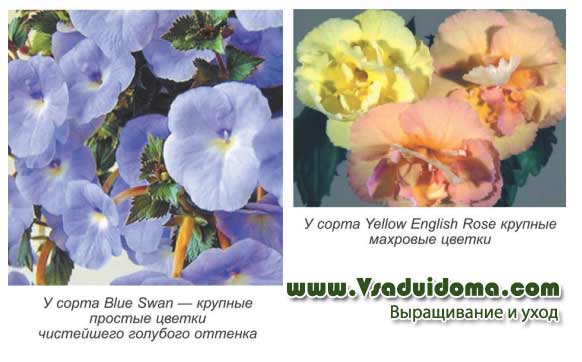
For me, the undoubted plus of the plant is that it "falls asleep" in winter. Rhizome nodules remain in the ground, which germinate with the arrival of spring.
To get beautiful flowering bushes of achimenes, you need to choose high-quality soil for it. Plants prefer a light peat-based substrate with various disintegrants (sand, perlite). Drainage is definitely needed, so I put a layer of expanded clay or pebbles on the bottom of the pot. The pot itself must also be of the correct size: for 3-4 nodules, a container with a volume of 1.5 liters is needed.
For active growth and flowering, Ahi-menes need a place with bright diffused lighting. Ideal placement - on the windowsills of western and eastern windows.
I plant rhizomes in March. I just lay them horizontally in a pot, sprinkle them with soil (layer 0.5-3 cm) and water them moderately. Usually rhizomes germinate in the second or third week after planting. One month after the sprouts appear, you can start feeding the plants. I apply fertilizers along with watering every 7-10 days, alternating organic and mineral. Moreover, I take a dose of fertilizer less than indicated in the instructions.
As soon as the sprouts have a third pair of leaves, I carefully cut off the top of the plant with nail scissors. This procedure requires jewelry precision, since the tip is very small. Such a pinching stimulates the branching of achimenes, and therefore an abundant flowering. If this is not done, the plant will be limited to one shoot.
I water the indoor achimenes as the earthen coma dries up. In the hot summer months, I moisturize the substrate each day or every other day.
Ahimenes can be kept on the windows, but at the end of May I take my plants into the garden, put the pots under a canopy in moderate shade. In the summer, I regularly water and fertilize Achimenes, and they, in turn, delight me with their flowering.
With a decrease in daylight hours (September-October), the plant begins to prepare for a dormant period. At this time, I reduce watering, stop feeding. As soon as the leaves begin to whisker. I completely stop watering. I do not prune the wilting shoots of achimenes so that the nutrients from the stem are transferred to the rhizomes. Many growers dig up rhizomes, dry them for 1-2 weeks in a well-ventilated area and store them in zip bags with vermiculite. I prefer to leave them in the ground until spring. I transfer the pots with rhizomes to a dry and warm basement, where they are well stored, do not grow moldy and do not germinate prematurely. The optimum storage temperature is 10 ° C or slightly higher.
As you can see, caring for this wonderful plant is not difficult. I hope that soon achimenes, along with gloxinia, violets and streptocarpus, will take pride of place in the collections of amateur florists.
WHEN LIGHT AND HEAT IS LITTLE
However, unstable weather conditions can cause a lot of problems. The first danger lurking young plants is that in March the heating is reduced and the temperature on the windowsills decreases. I don't use backlighting. Under such conditions, the development of young shoots is suspended, and the number two threat appears: the risk of waterlogging of the soil.
At the "drenched" Achimenes leaf tips turn black and dry; the lower shoots close to the surface of the substrate can infect pathogenic fungi. Sometimes, in order to save a plant, it has to be cuttings.
In conditions of dry air, spider mites often settle on Achimenes. I fight the pest with the help of Fitoverm.
How to dig up rhizomes and prepare for storage
Ahimenez can be left in a pot without digging up the rhizomes, and in the spring he will wake up again. But if you want to save space, plant a flower in the future and get some plants, then dig them up is the best solution.
The rhizomes are easily stored dry in zip bags in vermiculite, which is no doubt convenient and compact. Thus, a huge collection of different varieties can fit in just one small box.
In addition, rhizomes in bags do not require watering at all. Dug up, folded up and forgotten. Remembered only in the spring.
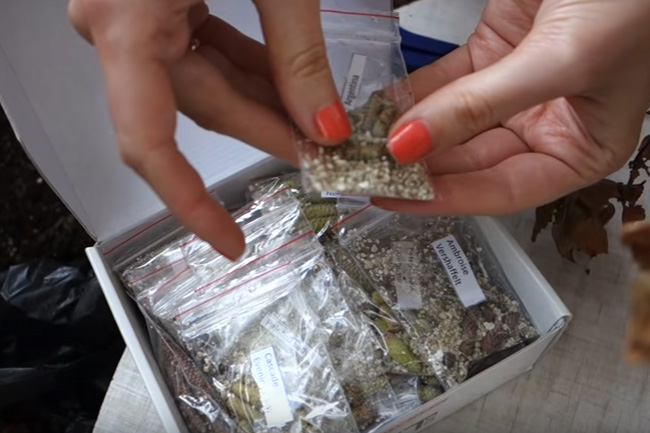
It should be noted that flower growers who are fond of Achimenes get special pleasure from digging up with rhizomes and often compare this process with harvesting. Because while the plant is in a pot, it is not known which rhizomes and how many of them he managed to grow during the period of growth and flowering.
Planting a plant
A plant germinated in a glass must be planted in a pot as carefully as possible. If possible, it is best to move the flower along with the soil in which it grew. Pots are selected shallow but wide. From one to 5-7 sprouts are planted in one container, depending on the volume of the pot. For growing Achimenes in pots without prior germination, choose the same flat wide containers. A plant with superficial growth of rhizomes does not like deep planting. Rhizomes are planted as follows.
- Begin to complete the flower pot with drainage. Ahimenes do not tolerate the accumulation of dampness, drainage is necessary for them.
- Having laid out a little sand and gravel on the bottom of the container, it is covered with more than two-thirds of the earth. The soil should contain peat, be loose and moist.
- Rhizomes are laid out on the surface in a horizontal position, their number depends on the volume of the pot.
- The planting material is covered with a layer of earth of 2-3 centimeters.
- If the soil is not moist enough, lightly watered with warm water.
- The pots are transferred to a warm, bright place, covered with cellophane or glass, creating the effect of a greenhouse.
Landing is complete. Next, you need to monitor the humidity and temperature conditions. Plants grow well at a temperature of 20-27 degrees. When the Achimenes begin to rise, they will need illumination of at least 16 hours a day, in the evenings they need to leave the lamps on.
Reproduction of achimenes
Method number 1. Rizomami
Propagation by rhizomes is the most effective and simple way, since achimenes grows a sufficient number of rhizomes during the season, with which the plant can be propagated. Some rhizomes become large enough to be divided into several parts.
- Shake out the top of the old soil from the achimenes container. Select all rhizomes. Divide large rhizomes (rhizomes 4–5 cm long) into several parts (the minimum size of a rhizome for planting is about 0.5 cm).
- So that later the plant does not get sick with fusarium or root rot, treat the rhizomes with Maxim, holding them in the solution for 30 minutes. Then spread the rhizomki on a damp substrate and cover with soil (it is enough to cover with a layer of 1–2 cm).
- Cover the planting with foil and place in a dark place for germination.
- With the appearance of the first shoots, remove the film, and move the container with the plantings to a bright place. Achimenes grown from rhizomes will begin to bloom three to four months after planting.
Method number 2. Seeds
The plant sets a lot of fruits if the faded flowers are not removed. Achimenes seeds can be purchased at the store or collected by yourself.To do this, wait until the seed pod becomes soft, open it, remove the seeds, dry and store in a dark, cool place before planting.
In the spring, in the first decade of March, you can start planting seeds. This method is good for obtaining a large number of plants, but the varietal qualities of most hybrids are lost when propagated by seeds.
- To plant seeds, use a ready-made violet mixture or make a substrate of peat, humus, sand and perlite. Fill shallow bowls with substrate, slightly moisten.
- Spread the seeds over the surface of the ground, pressing them slightly inward. Sprinkle with soil on top is not required.
- Cover the container with foil or glass and place in a warm and bright place.
- Ventilate the greenhouse daily, moisten the substrate with a spray bottle as needed.
- To prevent the shoots of ahmenes from stretching, additionally provide light to the seedlings in the morning and evening hours. Place the illumination lamp at a distance of 25 cm from the container. As the seedlings grow, increase the distance between planting and backlight.
- The first shoots will appear in 2-3 weeks. When the first pair of leaves grows, dive the seedlings, plant several shoots in one container, pinch the tops of each stem. Make two more picks (the period between procedures is 2-3 weeks), and for the last time, transplant the achimenes into a permanent "adult" pot. The flowering of seedlings grown from seeds will come only in the second year after planting.
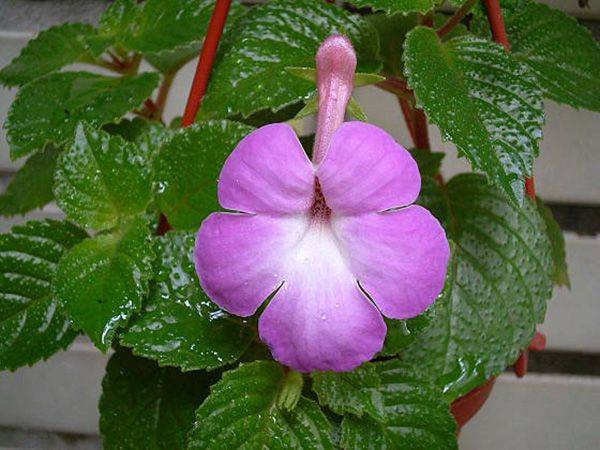 Varietal traits when propagated by seeds are not preserved
Varietal traits when propagated by seeds are not preserved
Method number 3. Cuttings
Propagation by cuttings is not very popular among flower growers (especially beginners), since the planting material often rots. But with proper care, you can get many new plants from cuttings. This method is especially suitable for growing new specimens of varietal Achimenes, since all varietal characteristics are preserved during reproduction in this way.
- Cut the escape. Slice it into cuttings with two pairs of leaves. Immerse the planting material for two hours in a solution of Epin or Heteroauxin (these are drugs that stimulate root formation).
- Before planting, dip the lower cut of the cutting into crushed activated carbon. This technique will avoid decay.
- Fill shallow planting containers with a mixture of perlite (vermiculite) and peat, plant the cuttings at an angle.
- Slightly moisten the soil and cover the container with plantings on top with a glass or transparent plastic lid.
- Place in a warm place, preferably with bottom heating. For example, you can arrange plantings on a heating battery.
- Periodically moisten the ground with water with a small amount of rooting stimulants (Epin or Kornevin), which will speed up the rooting process of cuttings by about two weeks.
- One week after rooting, repot the cuttings permanently in a small pot filled with regular substrate.
- The flowering of plants grown from cuttings will begin in the same season, but it will not be as abundant as when growing achimenes from rhizomes. You can wait for lush flowering only in the second year of growing achimenes from the cuttings.
Table: seasonal conditions for growing Ahmenes
| Spring Summer | Autumn winter | |
| Lighting | It grows well in a bright place, protected from direct sunlight. The plant can be placed on a window facing West or East, as well as a loggia or balcony. | A dark place is required during the dormant period. |
| Temperature | The temperature is moderate (20-25ºC), the plant prefers to grow outdoors in summer, so it is best to take the achimenes out to a balcony or loggia. | A suitable temperature for keeping achimenes in winter is 16-18ºC. |
| Humidity | The flower needs high humidity (85–90%). Achimenes needs to be sprayed regularly, but make sure that no water droplets fall on leaves and flowers.Spray water from a spray bottle around the plant. Put sphagnum moss in a tray and moisten it periodically. Another way to create humid conditions is to put an indoor fountain on a shelf or window sill next to a flower. | Moisturizing is not required in winter. |
Secrets of planting and transplanting at home
Planting scaly rhizomes (rhizomes) of achimenes is best from mid-February to early March. The planting mixture must be moisture and breathable. When making up the soil mixture, take peat, humus, sand, add perlite or vermiculite. You can also use any ready-made substrate with a slightly acidic or neutral reaction, for example, for violets.
Choose a wide and shallow container, since the root system of Achimenes is small. Experienced flower growers recommend planting only one rhizome in a 7 cm diameter bowl, if a 10 cm diameter pot, then no more than three pieces can be planted, and five to six erect varieties in a 15 cm diameter container. Rhizomes of ampelous Achimenes can be planted thicker.
Transplant features - step by step instructions
- Shake out the top of the old soil from the achimenes container. Select all rhizomes carefully. Examine them. Healthy rhizomes should be firm to the touch, dense, reddish-pink in color. Throw away any darkened, dry or moldy ones without regret. Healthy planting material will provide abundant flowering.
- Divide large rhizomes into several parts by cutting them with a clean knife. Remove weak shoots.
- Make good drainage. Pour small pebbles or expanded clay on the bottom of the container in a layer of 1.5 cm for aeration with rhizome of achimenes.
- Fill a pot 3/5 full with soil and moisten the substrate well with warm water.
- Spread the rhizomes on a moistened soil at a distance of two centimeters from each other, sprinkle on top with a layer of earth 1.5–2 cm thick.
- Cover the plantings with plastic wrap, a transparent plastic lid or glass and put an impromptu greenhouse in a dark place.
- Do not water anymore before germination, but be sure to ventilate twice a day, preferably in the morning and evening. Wipe off the condensation formed on the greenhouse cover. At the initial stage of growth, after a period of rest, the Ahimenes need water only as a stimulant for germination, while the seedlings use the moisture and nutrients stored in the rhizomes in the fall. They can germinate even without additional moistening of the soil in a container with planted rhizomes.
- After about two to three weeks, the first shoots should appear. As soon as this happened, move the container with the Ahimenes to a sunny place with diffused light. Achimenes does not need direct sunlight, but bright diffused light is very necessary for the formation of a compact bush and its abundant flowering.
- Moisten the soil sparingly, do not allow water to stagnate in the container with plantings, otherwise the rhizomes will begin to rot and you will not be able to save the plant. Please note that all dormant rhizomes in excessively moist soil can rot.
How to store rhizomes of Achimenes in winter
It is possible to remove Achimenes for the winter only after the aerial part has died out. Will not fade or turn yellow, but become completely dry.
Achimenes hibernate at temperatures not lower than 10 ° C. You cannot put them in the refrigerator. The optimal temperature during the rest period is 12 ° C, but it is difficult to provide it in a city apartment.
The flower survives from year to year with a warmer content. The main thing is not to put it next to heating devices, or in a place with high humidity. Still, try to keep it cool.
To preserve the rhizomes of achimenes until spring at room temperature of 18-20 ° C or higher, they need to be watered once a month. A little, so as not to wet, but only slightly moisten the surface of the soil. Otherwise, the rhizomes will dry out very much and may not wake up.
The temperature of 18-20 ° C is far from optimal, and if it is higher, with absolutely dry content, only a few of the largest rhizomes from the collection can survive.
Wintering of Achimenes in the ground
The easiest way to preserve the rhizomes of Achimenes in winter is directly in pots. They are placed in a cool, dark place. And they forget until February. Of course, if the wintering is really cool. Otherwise, the pot needs to be watered occasionally and little by little.
Sometimes at the end of the season, the rhizomes bulge out of the substrate. You cannot leave them open. A layer of dry peat of 1.5-2 cm should be poured on top.
If the flowers are planned to be planted, it is not recommended to wait for the sprouts to peck. They are dug up in early February and transferred to new pots.
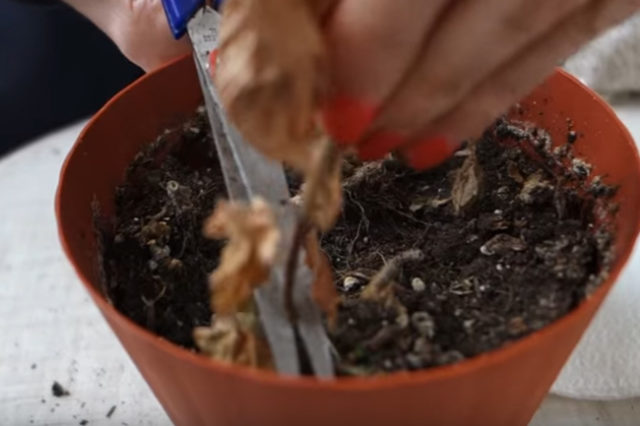 It is easiest to store Achimenes rhizomes in the same pot where they grew.
It is easiest to store Achimenes rhizomes in the same pot where they grew.
Storage of Achimenes' rhizomes out of the ground
It is difficult to leave a large collection in pots for the winter - it is not clear where to put them. Of course, if there is an insulated loggia, a balcony or a shed where the temperature does not drop below 10 ° C, there is no problem. Otherwise, you will have to dig out the rhizomes, rinse, rinse in a fungicide solution, dry, put in containers or bags with filler. And only after that send to rest.
For storage you can use:
- clean dry sand;
- peat;
- fine perlite;
- vermiculite.
Every month you will have to check the safety of the rhizomes, ventilate them, and, if necessary, remove or treat diseased ones. In February, the rhizomes of the Achimenes are planted in fresh soil.
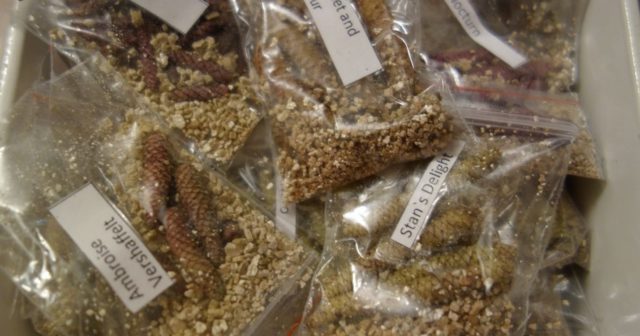 Achimenes stored in bags must be labeled
Achimenes stored in bags must be labeled

